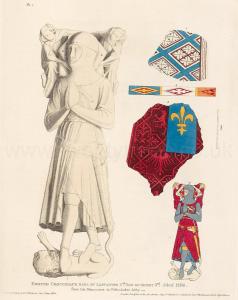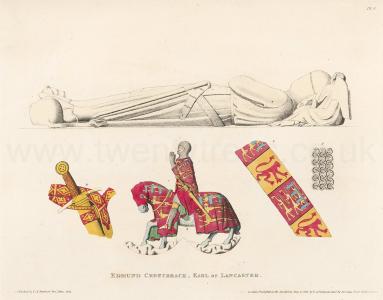Effigy of Edmund Crouchback, Earl of Lancaster
Effigy of Edmund Crouchback, Earl of Lancaster is in Monumental Effigies of Great Britain.
Was the second son of King Henry III by his wife Eleanor of Provence, and was born at London 16 January 1245. When he was yet but eight years of age, the Pope sent him a gold ring, investing him with the sovereignty of Sicily and Apulia. Not, however, unmindful of this titular and empty honour, from reverence to the then paramount authority, spiritual and secular, from whence it was derived, he stamped coin bearing the legend "Aidmundus Rex Scicilie." On the overthrow of Simon de Montfort and the rebellious Barons at the battle of Evesham, in 1265, he was invested with the Earldom of Leicester, the lands of Nicholas de Segrave, and the possessions of Robert de Ferrers, Earl of Derby, who in the following year, had renewed hostilities against Henry III. and was defeated at Chesterfield. He was also constituted High Seneschal or Steward of England in the place of the rebel de Montfort, and afterwards Earl of Champagne; he had, moreover, grants of the castle and town of Monmouth [Map], and numerous other lordships and estates. In 1269 he was marked with the cross at Northampton by Ottobon, the Legate of the Pope, with his elder brother Edward, the Earl of Gloucester, and many other nobles of the land: one of those nominal crusades which procured for the See of Rome so many golden crosses in current coin. In 1291 he had license from his brother King Edward I to crenellate or embattle his house, the Savoy in the Strand; which with its gardens and dependencies, had been granted to him by his mother Eleanor, and which had before belonged to her brother [Note. Uncle] Peter of Savoy. In 1295 Philip the Fair haughtily summoned King Edward I as Duke of Aquitaine to appear before the Peers of France, to answer for certain alleged outrages committed by his subjects towards some French mariners. The Earl of Lancaster was at first sent ambassador to the Court of France in order to arrange those differences, but a pretext was drawn from them by Philip to seize on some of the possessions of Edward as Duke of Aquitaine. The Earl of Lancaster was then dispatched with a military force into Gascogne; but his army being too inconsiderable to cope with that of the French, he was constrained to shut himself up in Bayonne [Map], where, suffering under mental vexation from his ill success, he sickened and died in 1296. A truce being concluded with France, his body was brought to England, and buried in a sumptuous tomb in the Abbey Church at Westminster [Map]. He had conscientiously directed that he should not be interred until his debts were paid. His first wife was Aveline, an account of whom has been given to illustrate her effigy; his second, Blanch, widow of Henry King of Navarre, Earl of Champagne and Brie, by whom he had three sons and a daughter.





Details. Plate 1. 1. Ornamental pattern on the pillow which supports the head. 2. Ditto on the lace of the hood. 3. Surcoat diapered with rampant lions, eagles displayed, ornamental crosses, &c. the points of the label and fleur-de-lys with which it is surmounted enlarged. 4. The whole figure as originally painted. Plate II. 1. Mailles enlarged. 2. Bearings on the belt. 3. Figure of the Earl on his barded horse, in the attitude of prayer, which occupies the trefoil ornament at the top of the tomb.

